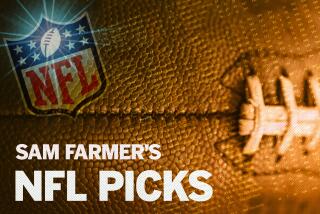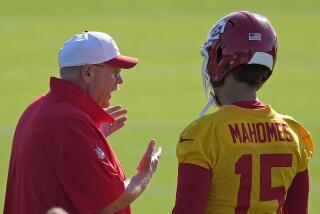Pro Football : NFL Isn’t Eager to Give Players More Than They Are Getting Now
- Share via
If it’s going to cost money, the National Football League’s 28 owners aren’t interested in ending their long fight with the NFL Players Assn.
Last season’s strike didn’t solve anything, and since then, the rival factions have been operating without a labor agreement.
“Salaries have gone up so much that the players are now getting 70% of the NFL’s gross revenue,” George Young, general manager of the New York Giants, said the other day. “That’s every dollar we get from television--and a lot more.”
About half of the owners’ total earnings come from their TV contracts.
“In most companies, when labor costs reach 30% (of the gross), they begin to worry,” Young said. “When I say that ours have risen in the last couple of years to 70%, I’m not pulling a figure out of a hat. That’s it.”
Thus the NFL is not interested in increasing player benefits, at least for the near future.
The NFL would be in considerably better shape financially if the club’s owners had agreed with Ed Garvey 6 years ago. Garvey, then the executive director of the NFLPA, proposed a settlement based on giving the players 55% of the league’s gross.
“We’d probably have compromised on 45 or 50%,” Garvey said privately.
The owners turned him down because they wanted to make their own determination on how much to pay the players.
Or as Young said: “We didn’t want (Garvey as) a partner in our business.”
It was an expensive decision, and perhaps the worst the NFL has made in 20 years.
Members of the league’s Management Council will meet in Chicago Thursday to try to come up with a way to improve the owners’ relationships with the players.
Each of the 28 clubs will be represented by one or two executives, some of whom are unhappy with the player-owner impasse that has existed in pro football for more than a year.
Though they say they can’t afford the expensive changes that the union is pushing, some owners would like some kind of accommodation leading to a new bargaining agreement, which would lead to, among other things, expansion.
Several kinds of free agency will be discussed.
“There’s a lot of uncertainty when you’re playing without a collective bargaining agreement,” Young said. “There’s a lot of frustration, and that’s never helpful.”
One of the strange sights in pro football this year is the sunny sidewalk in front of the stadium in Tempe, Ariz., when the Phoenix Cardinals are playing at home.
In the hour before the kickoff, there are people on the way in, people wishing to buy tickets from scalpers, and those trying to sell.
Dozens in the second group wear little signs announcing, “Need 2,” or “I Want 4.” Some walk around making the same point orally.
Dozens in the third group announce, “Buy here,” or, “Who wants good seats?”
Two things about this are unique to Arizona: It’s a market with as many would-be buyers as there are would-be sellers. And it’s a market with almost no action.
Almost nobody buys or sells.
The explanation is rooted in Cardinal ticket prices, which are the highest in the NFL. Some cost $200 each. Some are $95. Most are $25, and the average is $38.
Last-minute would-be buyers want to beat those prices. Would-be sellers are trying to make a dollar--or at least get their money back. And they’re all frustrated.
Two months ago, the NFL finally arrived in Arizona after 68 years in other states. And 60,000 to 65,000 of Arizona’s wealthiest have attended most games. But that’s a small percentage of the population, and the rest of the state can’t even see the Cardinals on TV.
In a stadium seating 72,000, there have been blackouts for every game except the Monday night opener on Sept. 12--when a TV station bought the last 3,000 seats.
A Phoenix journalist, Bob Hurt of the Arizona Republic, wrote an open letter to NFL Commissioner Pete Rozelle, seeking a clarification of the league’s blackout policy.
Before it can be lifted in a typical NFL city, the stadium must be sold out 72 hours before the kickoff.
But Hurt reminded Rozelle that the Cardinals aren’t typical. They’re the only pro team charging premium prices for most seats. On the 25-yard line, for example, Arizona sports fans pay $50 for $25 seats. The extra $25 is called a premium.
And there are vacancies in the $95 premium-ticket area every week.
Hurt’s point is that when the NFL considers local broadcasts of home games, unsold premium tickets shouldn’t count.
What did Rozelle say about that?
“He hasn’t answered,” Hurt said.
The most impressive of the NFL’s new quarterbacks Sunday was Mike Tomczak of the Chicago Bears, who replaced injured Jim McMahon and made it look easy in a 34-14 romp over the defending champion Washington Redskins.
Almost every pass Tomczak threw in the first quarter and a half--short, intermediate or long--was on the mark when the game was on the line.
Simultaneously, the Bear defense was so dominant with Mike Singletary and Richard Dent that the game was all over at the half, 20-0.
If Tomczak is really getting to be that accurate--if he wasn’t just lucky Sunday--the race could be about over in the National Football Conference.
“The Bears are the class,” said Giant executive Harry Hulmes.
Who’s the class of the other conference?
“Can the Buffalo Bills beat Cincinnati?” Hulmes asked. “That’s the question.”
If so, it may be answered a week from Sunday at Riverfront Stadium, when the Bills arrive with their Bear-type team. They have a crushing defense and just enough offense with quarterback Jim Kelly.
But characteristically, NFL teams on the rise don’t get there the first year.
With 5 weeks left in the 16-week regular season, there are still close playoff races in all six divisions.
At least three teams are contending in every division except the weak NFC Central. And the conference makes up for that with four contenders in the NFC East.
Nine teams in each conference are still in the Super Bowl race, and most of them are very much in it.
It’s popular to say that the NFL is a league of balanced mediocrity, but after 3 months, it looks more like a balance of powers.
Who is ready, right now, to write off the Raiders, who have come back from the dead? Or the Rams, who have won more games than all but four other teams? Or the 49ers, with all their striking power? Or the Houston Oilers? The Indianapolis Colts? The Minnesota Vikings?
Quote Department:
Al LoCasale, Raider executive, on Bo Jackson, whose 85 yards led all the running backs Sunday on the same field with Roger Craig: “Bo is a known quantity now, and they’re making him turn inside. He’s still running over people, but when he runs over one now, there’s another one right behind.”
Mike Merriweather, the all-pro linebacker who is still holding out on the 2-9 Pittsburgh Steelers: “They’d be undefeated if I was there.”
Tex Schramm, Dallas executive, on Tom Landry, coach of the 2-9 Cowboys: “He’s been an innovator, and that’s hard to maintain over a 29-year period.”
Tom Holmoe, San Francisco safety, on Raider rookie Tim Brown: “He’s got a strong upper body. With a lot of punt return guys, you just hit them and knock them over.”
Bill Walsh, San Francisco coach: “At one time--it seems like years ago--we had a great passing game. Now we’re average (and) we’ve lost a series of close games.”
Jerry Rice, the NFL’s best receiver last year, whose lack of production this year has contributed to the 49ers’ fall to third place: “Most of (Steve Young’s) passes are going to his left. If he has to throw to his right, he has to step across his body, and that’s really hard. And we use precise routes, so the timing isn’t there.”
More to Read
Go beyond the scoreboard
Get the latest on L.A.'s teams in the daily Sports Report newsletter.
You may occasionally receive promotional content from the Los Angeles Times.










